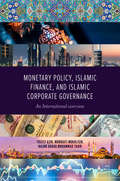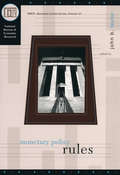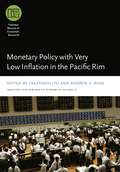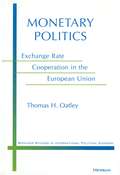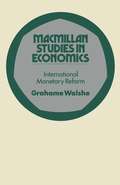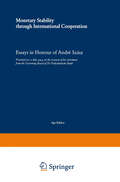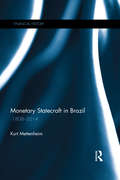- Table View
- List View
Monetary Policy in the Soviet Union: Empirical Analyses of Monetary Aspects of Soviet Economic Development
by Yasushi NakamuraThis book sheds light on the Soviet economic system, which claimed the eventual abolition of money, collapsed following a monetary turmoil. It argues that the cause of the economic collapse was embedded in the design of the economic system. The Soviet economic system restricted the market, but continued to use fiat money. Consequently, it faced the question for which no feasible answer seemed to exist: how to manage fiat money without data and information generated by the market? Using Soviet data newly available from the archives, the book evaluates the performance of the components of monetary management mechanism, discovers the continuous accumulation of open and secret government debts, and quantitatively analyzes the relationship between economic growth and the money supply to support the argument. The book concludes that the Soviet economic collapse marked the end of the long history of Soviet monetary mismanagement.
Monetary Policy in Times of Crisis: A Tale of Two Decades of the European Central Bank
by Massimo Rostagno Carlo Altavilla Giacomo Carboni Wolfgang Lemke Roberto Motto Arthur Saint Guilhem Jonathan YiangouThe first twenty years of the European Central Bank (ECB) offer a clear demonstration of how a central bank can navigate macroeconomic insecurity and crisis. As the global economy moves into a new phase of unheralded uncertainty, the story of the ECB holds multiple lessons of wider significance for the central banking community and researchers of monetary policy. This volume provides a unique account of how the ECB has reacted to the challenges confronting the euro area through its monetary policy, turning to innovative measures and unprecedented policy actions to fend off the various threats posed by the global financial turmoil of 2007/08, the euro area sovereign debt market crisis, and the subsequent period of anaemic growth and deflationary pressures. It also addresses some of the criticisms the ECB has faced regarding its policy initiatives. It identifies the ultimate motivation behind the ECB's cautious attitude in the early phases of the financial crisis, and its peculiar definition of price stability and attention for credit creation, as well as addressing the criticism that central banks were fundamentally unprepared to head off a major financial cataclysm as they were wedded to a deficient economic paradigm which made them blind to financial risks. It also shows that the ECB's unconventional low-interest policies have not compromised the position of financial intermediaries in the way commentators initially predicted they would. By condensing the facts and lessons of the first 20 years of the ECB, this volume will acquaint the reader with the structures and decision-making processes behind the complex, often controversial, crisis measures that were taken during some of the toughest economic challenges in the history of modern Europe, and provide them with fresh ex-post analysis on their effect on the real economy and inflation.
Monetary Policy in Times of Crisis: A Tale of Two Decades of the European Central Bank
by Massimo Rostagno Wolfgang Lemke Carlo Altavilla Giacomo Carboni Roberto Motto Arthur Saint Guilhem Jonathan YiangouThe first twenty years of the European Central Bank (ECB) offer a clear demonstration of how a central bank can navigate macroeconomic insecurity and crisis. As the global economy moves into a new phase of unheralded uncertainty, the story of the ECB holds multiple lessons of wider significance for the central banking community and researchers of monetary policy. This volume provides a unique account of how the ECB has reacted to the challenges confronting the euro area through its monetary policy, turning to innovative measures and unprecedented policy actions to fend off the various threats posed by the global financial turmoil of 2007/08, the euro area sovereign debt market crisis, and the subsequent period of anaemic growth and deflationary pressures. It also addresses some of the criticisms the ECB has faced regarding its policy initiatives. It identifies the ultimate motivation behind the ECB's cautious attitude in the early phases of the financial crisis, and its peculiar definition of price stability and attention for credit creation, as well as addressing the criticism that central banks were fundamentally unprepared to head off a major financial cataclysm as they were wedded to a deficient economic paradigm which made them blind to financial risks. It also shows that the ECB's unconventional low-interest policies have not compromised the position of financial intermediaries in the way commentators initially predicted they would. By condensing the facts and lessons of the first 20 years of the ECB, this volume will acquaint the reader with the structures and decision-making processes behind the complex, often controversial, crisis measures that were taken during some of the toughest economic challenges in the history of modern Europe, and provide them with fresh ex-post analysis on their effect on the real economy and inflation.
Monetary Policy in Transition: Inflation Nexus Money Supply in Postcommunist Russia (Studies in Economic Transition)
by M. NikolicThis book explores the disastrous economic consequences of pseudo lending for pseudo reforms that occurred when the IMF, as a representative of the West, pretended to aid the transition economy of post-communist Russia through stabilization while the Russian government promised reforms.
Monetary Policy, Inflation, and the Business Cycle: An Introduction to the New Keynesian Framework and Its Applications, Second Edition
by Jordi GalíThis revised second edition of Monetary Policy, Inflation, and the Business Cycle provides a rigorous graduate-level introduction to the New Keynesian framework and its applications to monetary policy. The New Keynesian framework is the workhorse for the analysis of monetary policy and its implications for inflation, economic fluctuations, and welfare. A backbone of the new generation of medium-scale models under development at major central banks and international policy institutions, the framework provides the theoretical underpinnings for the price stability–oriented strategies adopted by most central banks in the industrialized world.Using a canonical version of the New Keynesian model as a reference, Jordi Galí explores various issues pertaining to monetary policy's design, including optimal monetary policy and the desirability of simple policy rules. He analyzes several extensions of the baseline model, allowing for cost-push shocks, nominal wage rigidities, and open economy factors. In each case, the effects on monetary policy are addressed, with emphasis on the desirability of inflation-targeting policies. New material includes the zero lower bound on nominal interest rates and an analysis of unemployment’s significance for monetary policy.The most up-to-date introduction to the New Keynesian framework available A single benchmark model used throughout New materials and exercises includedAn ideal resource for graduate students, researchers, and market analysts
Monetary Policy, Inflation, and the Business Cycle: An Introduction to the New Keynesian Framework and Its Applications, Second Edition
by Jordi GalíThis revised second edition of Monetary Policy, Inflation, and the Business Cycle provides a rigorous graduate-level introduction to the New Keynesian framework and its applications to monetary policy. The New Keynesian framework is the workhorse for the analysis of monetary policy and its implications for inflation, economic fluctuations, and welfare. A backbone of the new generation of medium-scale models under development at major central banks and international policy institutions, the framework provides the theoretical underpinnings for the price stability–oriented strategies adopted by most central banks in the industrialized world.Using a canonical version of the New Keynesian model as a reference, Jordi Galí explores various issues pertaining to monetary policy's design, including optimal monetary policy and the desirability of simple policy rules. He analyzes several extensions of the baseline model, allowing for cost-push shocks, nominal wage rigidities, and open economy factors. In each case, the effects on monetary policy are addressed, with emphasis on the desirability of inflation-targeting policies. New material includes the zero lower bound on nominal interest rates and an analysis of unemployment’s significance for monetary policy.The most up-to-date introduction to the New Keynesian framework available A single benchmark model used throughout New materials and exercises includedAn ideal resource for graduate students, researchers, and market analysts
Monetary Policy Instruments for European Monetary Union
by Lukas MenkhoffTaking the Bundesbank's instruments as a starting point, this book discusses monetary policy instruments of a future European Central Bank. The book offers a systematic analysis of the issue, considering general theoretical arguments as well as the institutional situation in European countries.
Monetary Policy, Islamic Finance, and Islamic Corporate Governance: An International Overview
by Toseef Azid Murniati Mukhlisin Nashr Akbar Muhammad TahirToseef Azid, Murniati Mukhlisin, Nashr Akbar, and Muhammad Tahir bring together leading researchers to provide a state-of-the-art overview of the monetary policy, corporate governance, their legal and regulatory issues and procedures that structure Islamic banks (IBs) and other Islamic financial institutions (IFIs). Monetary policy and corporate governance are integral to macroeconomics and microeconomics while interest rates are a key part of monetary policy. Given negativity associated with interest rates, Islamic economists have sought alternative instruments. Focusing on the populous Muslim countries such as Pakistan, Malaysia, Turkey, Bangladesh and Indonesia this book explains how corporate and shari’ah governance structures work together under the umbrella of Islamic monetary policy, and in the process, provides guidelines that how such structures improve corporate social responsibility in order to serve the best interests of all stakeholders. The chapters included here cover various features of IBs and IFIs, corporate performance and strategic analysis of microfinance shari’ah based non-banking institutions, in order to investigate the role that these processes play in shaping broader global financial systems. For instance, it portrays different governance models of central bank of a country like Iran having a shari’ah based financial system. In conclusion, Monetary Policy, Islamic Finance, and Islamic Corporate Governance: An International overview explores the interrelationships between corporate governance from the perspective of shari’ah, banking industry and Islamic monetary policy. This is a must-read for the corporate sector, banking experts and monetary authorities including academics and postgraduate students.
Monetary Policy, Islamic Finance, and Islamic Corporate Governance: An International Overview
by Toseef Azid, Murniati Mukhlisin, Nashr Akbar and Muhamad TahirToseef Azid, Murniati Mukhlisin, Nashr Akbar, and Muhammad Tahir bring together leading researchers to provide a state-of-the-art overview of the monetary policy, corporate governance, their legal and regulatory issues and procedures that structure Islamic banks (IBs) and other Islamic financial institutions (IFIs). Monetary policy and corporate governance are integral to macroeconomics and microeconomics while interest rates are a key part of monetary policy. Given negativity associated with interest rates, Islamic economists have sought alternative instruments. Focusing on the populous Muslim countries such as Pakistan, Malaysia, Turkey, Bangladesh and Indonesia this book explains how corporate and shari’ah governance structures work together under the umbrella of Islamic monetary policy, and in the process, provides guidelines that how such structures improve corporate social responsibility in order to serve the best interests of all stakeholders. The chapters included here cover various features of IBs and IFIs, corporate performance and strategic analysis of microfinance shari’ah based non-banking institutions, in order to investigate the role that these processes play in shaping broader global financial systems. For instance, it portrays different governance models of central bank of a country like Iran having a shari’ah based financial system. In conclusion, Monetary Policy, Islamic Finance, and Islamic Corporate Governance: An International overview explores the interrelationships between corporate governance from the perspective of shari’ah, banking industry and Islamic monetary policy. This is a must-read for the corporate sector, banking experts and monetary authorities including academics and postgraduate students.
Monetary Policy Normalization: One Hundred Years After Keynes' Tract on Monetary Reform (Contributions to Economics)
by Paolo Savona Rainer Stefano MaseraIn light of the pickup of inflation at the end of 2021 and monetary policy shifts by the world's major central banks, this book examines interrelated issues in the normalization of monetary policy. It covers topics including the role of technological innovations such as derivatives and cryptocurrencies in monetary and financial management, the role of monetary policy in financial crises (especially public debt), and the major repricing needed for central banks and the global economy. In addition, the book discusses the problem of how flexible money should be and the importance of predictive tools for these decisions, with attention to the advances of languages for scientific research, including those on the workings of the economy. The work addresses the geopolitical and social challenges that have arisen as a result of the invasiveness of monetary policy in its various manifestations in the context of major leading currencies. It is aimed at scholars and students of monetary and financial economics.
Monetary Policy on the 75th Anniversary of the Federal Reserve System: Proceedings of the Fourteenth Annual Economic Policy Conference of the Federal Reserve Bank of St. Louis
by M. T. BelongiaWhen the 12 District Banks of the Federal Reserve System opened their doors for business on November 16, 1914, few observers could have foreseen the Fed's present role as a major, if not dominant, player in U. S. and world economic policymaking. After all, two previous attempts to create a central bank in this country had ended in failure. Moreover, much of the economic theory and institutional structure that have given rise to monetary policy's influence in recent years were not yet in place. Indeed, it would take the Fed more than 20 years to learn (by accident!) the power of open market operations. Clearly, the modern Federal Reserve System has found itself with powers and responsibilities that were not envisioned by its founders. These proceedings from a conference held at the Federal Reserve Bank of St. Louis on October 19-20, 1989, examine U. S. monetary policy from a variety of perspectives: a historical review of how it has affected aggregate economic performance; a positive analysis of why the Federal Reserve has chosen particular policy strategies; a review of normative arguments about what the Fed should pursue as its policy objective; a critique of how the Fed's "output"-the flow of monetary services in the U. S. economy-is measured; and, finally, a debate over the Fed's ability to influence real economic activity by changing the nominal quantity of money in circulation.
Monetary Policy Operations and the Financial System
by Ulrich BindseilSince 2007, central banks of industrialized countries have counteracted financial instability, recession, and deflationary risks with unprecedented monetary policy operations. While generally regarded as successful, these measures also led to an exceptional increase in the size of central bank balance sheets. The book first introduces the subject by explaining monetary policy operations in normal times, including the key instruments (open market operations, standing facilities, reserve requirements, and the collateral framework). Second, the book reviews the basic mechanics of financial crises as they have hit economies many times. The book then explains what central banks need to do to when financial markets and banks are impaired to fulfil their monetary policy and financial stability mandates. Besides demonstrating the need for non-conventional monetary policy measures, the book also highlights their dangers, such as moral hazard and increased central bank risk taking. The book draws a number of lessons from the crisis on non-conventional monetary policy operations, assessing what measures have worked well, and how a framework should be designed in future normal times such as to contribute to make financial crises less likely. Central bank monetary policy operations have traditionally been considered as a matter of practice, while the macroeconomic modelling of the transmission mechanism of monetary policy is regarded as a discipline relying on substantial theory ('monetary economics'). However, monetary policy operations can equally benefit from a theory, and from a normative framework to guide policy choices. The limited interest that monetary policy operations have found for many decades in academic economics may well have contributed to the many misunderstandings on central bank actions over recent years. This book provides a basis for a better theoretical understanding of real-world monetary policy operations.
Monetary Policy Rules (National Bureau of Economic Research Studies in Business Cycles #31)
by John B. TaylorThis timely volume presents the latest thinking on the monetary policy rules and seeks to determine just what types of rules and policy guidelines function best. A unique cooperative research effort that allowed contributors to evaluate different policy rules using their own specific approaches, this collection presents their striking findings on the potential response of interest rates to an array of variables, including alterations in the rates of inflation, unemployment, and exchange. Monetary Policy Rules illustrates that simple policy rules are more robust and more efficient than complex rules with multiple variables. A state-of-the-art appraisal of the fundamental issues facing the Federal Reserve Board and other central banks, Monetary Policy Rules is essential reading for economic analysts and policymakers alike.
Monetary Policy Rules (National Bureau of Economic Research Studies in Business Cycles #31)
by John B. TaylorThis timely volume presents the latest thinking on the monetary policy rules and seeks to determine just what types of rules and policy guidelines function best. A unique cooperative research effort that allowed contributors to evaluate different policy rules using their own specific approaches, this collection presents their striking findings on the potential response of interest rates to an array of variables, including alterations in the rates of inflation, unemployment, and exchange. Monetary Policy Rules illustrates that simple policy rules are more robust and more efficient than complex rules with multiple variables. A state-of-the-art appraisal of the fundamental issues facing the Federal Reserve Board and other central banks, Monetary Policy Rules is essential reading for economic analysts and policymakers alike.
Monetary Policy under Uncertainty: Historical Origins, Theoretical Foundations, and Empirical Evidence
by Oliver SauterOliver Sauter analyzes three aspects of monetary policy under uncertainty. First he shows that the terms risk and uncertainty are often wrongly used as synonyms despite their different meanings. The second aspect is the proper examination and incorporation of uncertainty into a monetary policy framework. The author undertakes systematization with a closer look at each identified form of uncertainty. Thirdly, he focuses on the quantification of uncertainty from two different perspectives, either from a market perspective or from a central bank perspective.
Monetary Policy with Very Low Inflation in the Pacific Rim (National Bureau of Economic Research East Asia Seminar on Economics #15)
by Takatoshi Ito Andrew RoseExtremely low inflation rates have moved to the forefront of monetary policy discussions. In Asia, a number of countries—most prominently Japan, but also Taiwan and China—have actually experienced deflation over the last fifteen years. Monetary Policy with Very Low Inflation in the Pacific Rim explores the factors that have contributed to these circumstances and forecasts some of the potential challenges faced by these nations, as well as some potential solutions. The editors of this volume attribute low inflation and deflation in the region to a number of recent phenomena. Some of these episodes, they argue, may be linked to rapid growth on the supply side of economies. Here, inadequate demand policy can produce what is referred to as a "liquidity trap" in which the expectation of falling prices encourages agents to defer costly purchases, thereby discouraging growth. Low inflation rates can also be traced to the presence of a "zero-lower bound" on interest rates, as well as the inflation-targeting phenomenon. Targets have been set so low, the editors argue, that in some cases a few bad shocks lead to deflation.
Monetary Policy with Very Low Inflation in the Pacific Rim (National Bureau of Economic Research East Asia Seminar on Economics #15)
by Takatoshi Ito Andrew K. RoseExtremely low inflation rates have moved to the forefront of monetary policy discussions. In Asia, a number of countries—most prominently Japan, but also Taiwan and China—have actually experienced deflation over the last fifteen years. Monetary Policy with Very Low Inflation in the Pacific Rim explores the factors that have contributed to these circumstances and forecasts some of the potential challenges faced by these nations, as well as some potential solutions. The editors of this volume attribute low inflation and deflation in the region to a number of recent phenomena. Some of these episodes, they argue, may be linked to rapid growth on the supply side of economies. Here, inadequate demand policy can produce what is referred to as a "liquidity trap" in which the expectation of falling prices encourages agents to defer costly purchases, thereby discouraging growth. Low inflation rates can also be traced to the presence of a "zero-lower bound" on interest rates, as well as the inflation-targeting phenomenon. Targets have been set so low, the editors argue, that in some cases a few bad shocks lead to deflation.
Monetary Politics: Exchange Rate Cooperation in the European Union (Michigan Studies In International Political Economy)
by Thomas H. OatleyA single currency--and the necessary prior condition of exchange rate cooperation and the stabilization of exchange rates--has been an elusive goal of many European leaders for more than twenty years. While much of the literature on exchange rate cooperation within the European Union focuses on the integration of national economies as the driving force, Thomas Oatley draws on public choice models to develop an explanation of exchange rate cooperation based on domestic politics. The author then tests hypotheses derived from this model in a detailed consideration of the various efforts to stabilize currencies since the 1970s. Oatley argues that monetary policy has distributional effects and is used by policy makers to achieve domestic policy goals. Thus domestic politics plays an important role in defining the approach leaders take to monetary integration. Oatley suggests that leaders supported the creation of the European Monetary System because governments saw a link to the Bundesbank as a useful instrument to help slow the growth of wages, redistribute income from labor to capital, and achieve domestic stabilization. The later collapse of the System reflected the unwillingness on the part of many leaders to continue to follow the Bundesbank's lead as well as the Bundesbank's own reservations about monetary integration. Given the rising strife in countries such as France over the domestic costs of monetary integration, Oatley's domestic politics explanation will be useful in understanding the continued efforts of European policy makers to work towards an integrated currency. This book should appeal to political scientists and economists interested in international cooperation, the European Union and exchange rate systems. Thomas Oatley is Assistant Professor of Political Science, University of North Carolina.
Monetary Reform and the Bellagio Group Vol 2: Selected Letters and Papers of Fritz Machlup, Robert Triffin and William Fellner
by Carol M Connell Joseph SalernoThe Bellagio Group was founded at a time of global economic crisis. This collection brings together the private correspondence and published papers of the Group’s founders, creating a picture of the personalities, issues, debates and compromises leading to the adoption of flexible exchange rates and a modified Triffin plan.
Monetary Reform and the Bellagio Group Vol 2: Selected Letters and Papers of Fritz Machlup, Robert Triffin and William Fellner
by Carol M Connell Joseph SalernoThe Bellagio Group was founded at a time of global economic crisis. This collection brings together the private correspondence and published papers of the Group’s founders, creating a picture of the personalities, issues, debates and compromises leading to the adoption of flexible exchange rates and a modified Triffin plan.
Monetary Stability through International Cooperation: Essays in Honour of André Szász
by Age F. P. Bakker Henk Boot Olaf Sleijpen Wim VanthoorMonetary Stability through International Cooperation contains essays written by high ranking policy makers in the field of central banking and international finance, written in honour of André Szász, who has been Executive Director of De Nederlandsche Bank since 1973, responsible for international monetary relations. Colleagues from several other central banks, from finance ministries and from international institutions pay tribute to him by analysing the conditions fostering European as well as global monetary stability. The book provides an inside view of the thinking of monetary officials at the turn of 1993/1994, when the currency turmoil in the ERM of mid-1993 had subsided and views on its implications for exchange rate management and, more generally, for European integration were taking shape. Topics include exchange rate stabilisation, policy coordination and central bank independence. A second section, on the international monetary system, includes essays on the policy implications of present day dynamic financial markets as well as the role of the IMF. This book, written by `insiders for an insider', provides valuable insights to those who are interested in contemporary international monetary relations.
Monetary Statecraft in Brazil: 1808–2014 (Financial History)
by Kurt MettenheimBrazil has one of the world’s fastest growing economies and a fascinating history underpinning its evolution. This book presents an analysis of the state’s role in monetary policy, from the latter days of Portuguese rule, to the present day. Based on a variety of unknown archival sources, this study offers an alternative explanation for the rise and fall of Brazilian currencies. Monetary statecraft is a theory that accounts for the open ended, autonomous character of politics, the complex, recursive phases of public policy, and political development in the traditional sense of social inclusion. Unfortunately, there are few precedents for this type of analysis. This book fills this gap by tracing how Brazilian policy makers and observers have sought, experimented with, and reflected on a variety of forms and solutions for monetary policy since 1808. This book will be of interest to economists, financial historians and those interested in the history and economy of Brazil.
Monetary Statecraft in Brazil: 1808–2014 (Financial History)
by Kurt MettenheimBrazil has one of the world’s fastest growing economies and a fascinating history underpinning its evolution. This book presents an analysis of the state’s role in monetary policy, from the latter days of Portuguese rule, to the present day. Based on a variety of unknown archival sources, this study offers an alternative explanation for the rise and fall of Brazilian currencies. Monetary statecraft is a theory that accounts for the open ended, autonomous character of politics, the complex, recursive phases of public policy, and political development in the traditional sense of social inclusion. Unfortunately, there are few precedents for this type of analysis. This book fills this gap by tracing how Brazilian policy makers and observers have sought, experimented with, and reflected on a variety of forms and solutions for monetary policy since 1808. This book will be of interest to economists, financial historians and those interested in the history and economy of Brazil.





